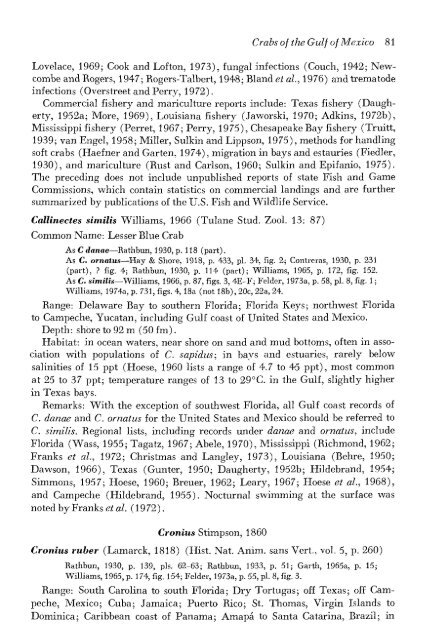Create successful ePaper yourself
Turn your PDF publications into a flip-book with our unique Google optimized e-Paper software.
Crabs of the Gulf of Mexico 81<br />
Lovelace, 1969; Cook and Lofton, 1973), fungal infections (Couch, 1942; Newcombe<br />
and Rogers, 1947; Rogers-Talbert, 1948; Bland eZ al., 1976) andtrematode<br />
infections (Overstz'eet and Perry, 1972).<br />
Commercial fishery and mariculture reports include: Texas fishery (Daugherty,<br />
1952a; More, 1969), Louisiana fishery (Jaworski, 1970; Adkins, 1972b),<br />
Mississippi fishery (Perret, 1967; Perry, 1975), Chesapeake Bay fishery (Truitt,<br />
1939; van Engel, 1958; Miller, Sulkin and Lippson, 1975), methods for handling<br />
soft crabs (Haefner and Garten, 1974), migration in bays and estauries (Fiedler,<br />
1930), and mariculture (Rust and Carlson, 1960; Sulkin and Epifanio, 1975).<br />
Tlie preceding does not include unpublished reports of state Fish and Game<br />
Commissions, which contain statistics on commercial landings and are further<br />
sim:imarized by publications of the U.S. Fish and Wildlife Service.<br />
Callinectes sirnilis Williams, 1966 (Tulane Stud. Zool. 13: 87)<br />
Common Name: Lesser Blue Crab<br />
As C danae—Raihhun, 1930, p. 118 (part).<br />
As C. onialus—Hay & Shore, 1918, p. 433, pi. 34, fig. 2; Conlreras, 1930, p. 231<br />
(part), ? fig. 4; Ratlibun, 1930, p. 114 (part); Williams, 1965, p. 172, fig. 152.<br />
As C. si"mi7i.s—Williams, 1966, p. 87, figs. 3, 4E^F; Felder, 1973a, p. 58, pi. 8, fig. 1;<br />
Williams, 1974a, p. 731, figs. 4, 18a (not 18b), 20c, 22a, 24.<br />
Range: Delaware Bay to southern Florida; Florida Keys; northwest Florida<br />
to Campeche, Yucatan, including Gulf coast of United States and Mexico.<br />
Depth: shore to 92 m (50 fm).<br />
Habitat: in ocean waters, near shore on sand and mud bottoms, often in association<br />
with populations of C. sapidus; in bays and estuaries, rarely below<br />
salinities of 15 ppt (Hoese, 1960 lists a range of 4.7 to 45 ppt), most common<br />
at 25 to 37 ppt; temperature ranges of 13 to 29°C. in the Gulf, slightly higher<br />
in Texas bays.<br />
Remarks: With the exception of southwest Florida, all Gulf coast records of<br />
C. danae and C. ornatus for the United States and Mexico should be referred to<br />
C. sirnilis. Regional lists, including records under danae and ornatus, include<br />
Florida (Wass, 1955; Tagatz, 1967; Abele, 1970), Mississippi (Richmond, 1962<br />
Franks et al., 1972; Christmas and Langley, 1973), Louisiana (Behre, 1950<br />
Dawson, 1966), Texas (Gunter, 1950; Daugherty, 1952b; Hildebrand, 1954<br />
Simmons, 1957; Hoese, 1960; Breuer, 1962; Leary, 1967; Hoese ei al, 1968),<br />
and Campeche (Hildebrand, 1955). Nocturnal swimming at the surface was<br />
noted by Franks e:« «Z. (1972).<br />
Cronius Stimpson, 1860<br />
Cronius ruber (Lamarck, 1818) (Hist. Nat. Anim. sans Vert., vol. 5, p. 260)<br />
Rathbun, 1930, p. 139, pis. 62-63; Rathbun, 1933, p. 51; Gartli, 1965a, p. 15;<br />
Williams, 1965, p. 174, fig. 154; Felder, 1973a, p. 55, pi. 8, fig. 3.<br />
Range: South Carolina to south Florida; Dry Tortugas; off Texas; off Campeche,<br />
Mexico; Cuba; Jamaica; Puerto Rico; St. Thomas, Virgin Islands to<br />
Dominica; Caribbean coast of Panama; Amapa to Santa Catarina, Brazil; in

















